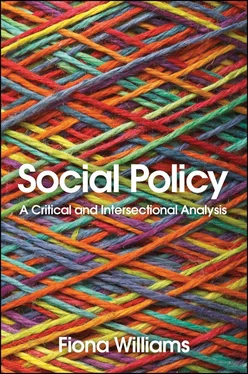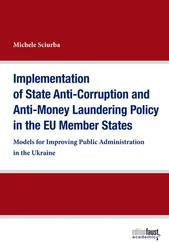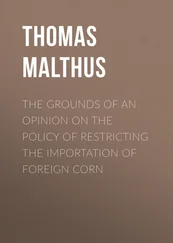Much of the relevant political literature on crisis refers to the contemporary crisis of democracy, seen especially in the distrust of political elites, the fatigue of and with social democracy, and the rise of ethno-nationalist populist leaders (Crouch 2011; Streeck 2014; Brown 2015). This is an important dimension, discussed in chapter 4in relation to Brexit and in chapter 7in relation to participatory democracy. But it is of a different order to, and more consequential of, the economic, social and planetary crises discussed here.
The global financial crisis
Analyses of the shifts to austerity welfare generally locate its origins in the global financialized capitalist economy, a system which, along with its ideological promoter, neoliberalism, had been supported by national and supranational governments and international agencies (IMF, World Bank) but whose internal contradictions created the global financial crisis (Seymour 2014; Farnsworth and Irving 2015; Béland and Mahon 2016; Olafsson et al. 2019). Capitalism of the twenty-first century has been, especially in the US and the UK, dominated by finance capital, in which, in the context of depreciated wages, products were buyable for many only through borrowing via credit or mortgages (thereby generating profit for the lenders). Mass inability to repay debts accumulated and many banks went bust. In this sense, it was an enduring tension that became an acute crisis. In the UK this hit in 2007 when New Labour was in power. As in a number of other states, the government responded with bank and financial-sector bailouts; for example, they underwrote £51 billion of the debts of the mortgage lender Northern Rock. Unlike their successors they maintained public spending in line with their anti-poverty strategy (House of Commons 2009; Bennett 2019). However, locating austerity as a result of policies to resolve the contradictions of finance capitalism, while crucial in its particularity, tells only a part of the story. There are other social and environmental aspects which emerge from the contradictions of contemporary capitalism that are particularly salient to understanding the landscapes of austerity welfare and resistances to it.
I start with Nancy Fraser’s feminist critique of the North Atlantic Financial Crisis, which argues that most analyses of the crisis are gender blind, and the obverse, that feminist theory lacks a framework that links social changes affecting gender relations to this crisis (Fraser 2013). She argues that current global crises are multidimensional and that we need an integrated approach to understand how these dimensions relate to each other. This she provides through a critical reinterpretation of Karl Polanyi’s The Great Transformation (Polanyi [1944] 1957), a tripartite analysis of the history of capitalist crisis over the nineteenth and first half of the twentieth century. In brief, Polanyi’s argument is that capitalism’s self-destructive impulse lies in its turning land, labour and money into ‘fictitious commodities’. The marketization of each of these domains led to despoiling the land, demoralizing the labourer, and destroying the value of money through speculation.
In Fraser’s view, it is the integrated nature of this analysis that is important, along with Polanyi’s recognition of the significance of political mobilization, in this case through the conflict between capital and labour, as the key to effect social and economic change. Fraser updates this mobilization to include the significance of feminist, anti-racist and environmentalist struggles. Accordingly, she rewrites Polanyi’s three crisis-prone constituents of land, labour and money as the interlinked systemic crises of ecology, social reproduction and finance, respectively. She argues that the same impulse of ‘fictitious commodification’ is seen today in each of these global crises, with a similar result of destroying the value of the planet’s resources, of care and of money, respectively. Thus, in relation to the last of these, money, Fraser maintains that it was speculation that fuelled the global financial crisis in which investment was destabilized and devalued. This led not only to austerity policies, whose disproportionate and immiserating penalties have already been described, but also to undermining the capacity of money to store value for the future. The endangering of future societies is at the heart of Fraser’s analysis. Before explaining what this means for the crises of social reproduction and ecology, I suggest that there is a dimension missing in her analysis.
While Fraser mentions the three most significant areas of struggle today as feminist, anti-racist and environmentalist, she identifies only crises attached to the first and last of these – social reproduction and ecology. Issues of racism, immigration and postcolonialism tend to be folded into her explication of these two rather than also providing an understanding of the specificity of the relationship between the logics of capitalism and colonialism over time. Since the 1990s there has been a dramatic dovetailing of immigration and domestic racializing policies (de Genova 2018). First, contradictions between the demands of global capitalism for mobile labour and state tightening of border controls (supported by ethno-nationalist populist politics), alongside the acceleration (at times) and diversification of transnational migration and asylum seeking, has created growing injustices and inequalities (Faist 2018). Second, global widening of social, economic and geo-political inequalities has disproportionately affected minority ethnic groups and indigenous people in spite of civil rights, the end of Apartheid, anti-racist and postcolonial struggles. Howard Winant describes this as a ‘racial crisis’ in the Gramscian sense of an interregnum in which emancipation is not yet realized but when ‘morbid symptoms’ appear (Winant 2006: 988). Similarly, Michael Dawson, in a critique of Fraser, says: ‘it is “apparent” when we observe the rise of racial strife in the United States and ethno-religious conflict in Europe that racial and ethnic logics are generating crises as deep and perhaps even more dangerous than those of capital, reproduction, the ecology, or politics’ (Dawson 2016: 145). (This is a crisis that found its voice in the Black Lives Matter movement.) Thus the combined logics of white supremacy and capitalism in different forms have given rise over time to both exploitation and expropriation.
I term this missing crisis as one of racialized borders and come back to how to define this later. What is important here is that it points to an understanding of capitalist development from the sixteenth century as inextricably tied into the politics of slavery abolition, imperialism, colonialism, eugenics, postcolonial racism, globalization and post-racial racism. This is not to say that racism is determined by capitalism but that the two have intersected economically and culturally over time ever since colonial enterprises emerged in ‘the long sixteenth century’ (Wallerstein 2004; Bhattacharyya 2018). Profits from imperialism and from slave plantations were central to industrialization, and the racial structuring of the labour market has contributed to conflicts and tensions within capitalism. It is not just, as Fraser critiques, that Polanyi’s theory of the history of capitalism’s tendency to self-destruction ignores the difficulties that women have had even to sell their labour power, but also, as Bhambra and Holmwood (2018) argue, that it omits recognition of the significance of racialized labour. This is because it is based on a conception of a worker who sells their labour power only for it to become commodified. But this is a worker who is free to do so in the first place. An enslaved worker’s labour power is embodied in their enslavement and carries no such freedom to be sold into commodification. To be fair to Fraser, in a later response to Dawson’s critique mentioned above, she begins to delineate this distinction between exploitation (the commodifiable worker) and expropriation (the unfree worker) and how they intersect over time and space in ‘four regimes of racialized accumulation’ (Fraser 2016a).
Читать дальше












